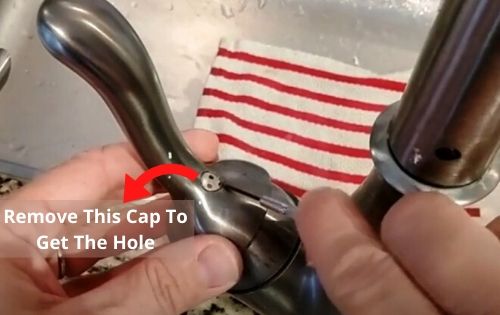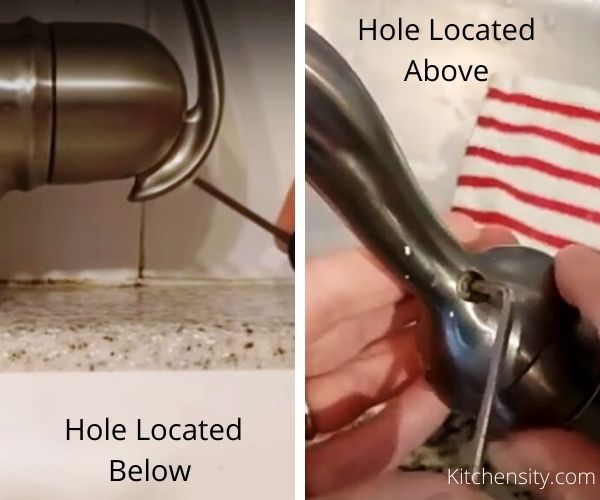To tighten a loose Moen single-handle kitchen faucet, start by removing the plastic cap. Insert an Allen wrench or hex wrench into the hole and turn it counterclockwise to unscrew. Once the cap is off, you’ll see the valve or cartridge beneath, covered by a collar. Remove the collar to reveal a brass ring securing the valve. Using a tool that fits or even a knife or pry tool, tighten the brass ring in a clockwise direction.
Exercise caution not to overtighten; find a middle ground between too tight and too loose. This straightforward process will help stabilize your Moen single-handle kitchen faucet and prevent further wobbling. Simply attach all the parts in their designated positions, and you’re finished – it’s as simple as that!

Key Takeaways:
- Remove the Plastic Cap.
- After that, remove the Handle And the Collar.
- Finally, tighten the Ring to make the Faucet Handle Tight.
Table of Contents
- 1 Step-By-Step Guide To Tighten A Loose Moen Single Handle Kitchen Faucet
- 2 How To Tighten A Loose Moen Kitchen Faucet Base?
- 3 Some Important Questions
- 3.1 1. Why Does Your Kitchen Faucet Keep Coming Loose?
- 3.2 2. Alternative Methods To Tighten A Loose Moen Single-Handle Kitchen Faucet
- 3.3 3. How To Tighten A Loose Moen Kitchen Faucet Spout?
- 3.4 4. Why Is Moen Single-Handle Kitchen Faucet Hard To Swivel?
- 3.5 5. What Should You Do If The Cartridge In Your Moen Kitchen Faucet Is Loose?
- 3.6 6. Why Your Moen Kitchen Faucet Is Hard To Turn?
- 3.7 6. How Do You Remove A Moen Faucet Handle Without Visible Screws?
- 4 Final Thoughts: How To Tighten A Loose Moen Single Handle Kitchen Faucet?
- 5 FAQ’s (Frequently Asked Questions)
Step-By-Step Guide To Tighten A Loose Moen Single Handle Kitchen Faucet
For a more detailed understanding and step-by-step guidance, read this comprehensive tutorial.
Materials You Will Need
- Allen Wrench Or Hex Wrench.
- Screwdriver.
- Adjustable Wrench or Pliers.
Step 1: Remove The Plastic Cap.

Your first and foremost job is to off the valves (both hot and cold water) so that there is no unwanted water and then remove the plastic cap or plug that is situated just below or above the faucet handle. You can remove it with any pry tool or screwdriver, just take the tool to pop that off.
Step 2: Remove The Handle And Collar.

After removing the plastic cap, take an Allen wrench or hex wrench put it inside the hole, and unscrew it in a counterclockwise direction to open the handle. The faucet handle should easily come out.

Now, you have to remove the collar that is covering the valve inside. Just turn the collar in the counterclockwise direction with your hand and it should easily come out.

If it’s overly tight, you can use an adjustable wrench or pliers to loosen it. However, exercise caution and avoid applying excessive pressure to prevent scratching or potential breakage. To protect it, you can cover it with a cloth or rubber band and then use the wrench to remove it.
Step 3: Tighten The Ring To Make The Faucet Handle Tight.
Finally, after removing the collar, you will notice a valve is held tight by a ring (usually brass but it can be any metal or plastic). You have to tighten the ring using any appropriate tool. You can use a knife or pry tool or whatever fits in it and try to make it tight in a clockwise direction.

But make sure, not to make it too tight, otherwise, the faucet handle will also be tight. Try to keep it in the middle, not so tight or loose. After that, attach all the parts accordingly back to their position and turn on the valves. That’s it.
Now it’s time for the second problem to solve.
You May Also Like: How To Remove Flow Restrictor From The Kitchen Faucet?
How To Tighten A Loose Moen Kitchen Faucet Base?
To tighten a loose Moen kitchen faucet base, start by turning off both the hot and cold water valves to prevent flooding. If the mounting nuts are dirty, clean them with a toothbrush and cleanser, although this step is optional. Then, use an adjustable wrench or pliers to tighten the mounting nuts in a clockwise direction. For older faucets, a basin wrench may be necessary for a snug fit, but it’s still possible to tighten them without one.
You have learned to tighten the single-handle Moen kitchen faucet and now, it’s time to tighten the base. When the base becomes loose, it feels so annoying, and it prevents the ability of the faucet to turn on and off efficiently.
Also, a loose faucet base can move freely (wiggles) and may cause a leak as it may crack the water lines supplying the faucet. So, it’s essential to solve the matter as soon as possible. But don’t panic, it is also an easy task that you can do yourself.
You Will Need
- Adjustable Wrench or Pliers.
- A cloth or towel.
- Toothbrush.
Step 1: Off The Valves
Before starting, you should off both the hot and cold water valves to prevent any unwanted water flooding.
Step 2: Cleaning The Mounting Nuts (Not Mandatory)
If your mounting nuts or the nuts that hold the faucet are dirty, then take the toothbrush and clean it. You can spray some cleanser and wipe it with a towel or cloth.
This step is not mandatory but doing this will help you to see the nuts. But if your nuts are clean then you can skip this step.
Step 3: Tightening The Mounting Nuts
Once you clean it, it’s time to tighten it. Take the adjustable wrench or plier basically which fits the nut perfectly and turn it in a clockwise direction. This method works 100 percent whenever my faucet becomes loose. That’s it !!!

For older faucets, a basin wrench may be necessary, as other wrench types may not fit snugly. This can make the tightening process a bit challenging. But, this simply doesn’t mean that without a basin wrench, you can’t remove it.
You May Also Like: How To Remove Kitchen Faucet Without Basin Wrench?
Some Important Questions
1. Why Does Your Kitchen Faucet Keep Coming Loose?
A loose faucet can be caused by various reasons such as wear and tear, improper installation, water pressure, and corrosion. Over time, the parts of the faucet can become loose due to repeated use, causing the faucet to wobble or move around.
- Improper Installation: It can also lead to a loose faucet. If the faucet is not installed correctly, it may not be secured properly, causing it to become loose. In addition, if the mounting hardware is not tightened enough during installation, it can cause the faucet to become loose over time.
- Water Pressure: It can also cause a loose faucet. High water pressure can put extra strain on the faucet and its components, causing them to become loose. If the water pressure is too high, it can also damage the faucet and cause leaks.
- Corrosion: It can also be a cause of a loose faucet. Over time, the parts of the faucet can corrode, causing them to become weaker and eventually break. Corrosion can be caused by exposure to water, air, and other elements, as well as the type of metal used in the faucet.
- Hard Water: In some cases, hard water can also cause mineral buildup that can contribute to a loose faucet.
Regardless of the cause, it is important to address a loose faucet as soon as possible to prevent further damage or potential leaks. Regular maintenance and proper installation can help prevent a loose faucet and extend the life of your kitchen or bathroom fixture.
Also Read – How To Clean A Delta Pull-Down Kitchen Faucet Aerator?
2. Alternative Methods To Tighten A Loose Moen Single-Handle Kitchen Faucet
Here are some alternative methods you can try to tighten a loose Moen single-handle kitchen faucet.
- Use Pliers Or An Adjustable Wrench: Instead of a basin wrench, you can use pliers or an adjustable wrench to tighten the mounting nut. Protect the faucet finish with a cloth or tape before using the pliers or wrench.
- Use A Rubber Jar Opener: A rubber jar opener can also be used to grip the mounting nut and turn it clockwise to tighten the faucet.
- Use A Strap Wrench: A strap wrench is another tool that can be used to grip the mounting nut and tighten the faucet. It is a handy tool that can be adjusted to fit the size of the nut.
- Tighten The Screws: If the mounting nut is inaccessible, you can try tightening the screws that hold the faucet handle in place. Use a screwdriver to tighten the screws and see if it helps to stabilize the faucet.
Remember to turn off the water supply to the faucet before attempting any of these methods, and always take precautions to protect the finish of the faucet.
Also Read – Low Water Pressure In The Kitchen Sink
3. How To Tighten A Loose Moen Kitchen Faucet Spout?
To tighten a loose Moen kitchen faucet spout, start by turning off the water supply to the faucet. Then, remove the spout by locating the set screw underneath and using an Allen wrench to loosen and remove it. Once the spout is removed, tighten the mounting hardware underneath using a wrench in a clockwise direction. After tightening, reattach the spout by aligning it with the mounting post and securing it with the set screw. Finally, turn on the water supply and check for any leaks.
With just a few basic tools and some simple steps, you can have your faucet spout securely attached in no time, allowing you to enjoy uninterrupted dishwashing and cooking. So let’s dive in and get that loose spout tightened up! Here are the steps to tighten a loose Moen kitchen faucet spout:
- Turn Off The Water Supply: Before you start tightening the faucet spout, turn off the water supply to the faucet. This will prevent any water from flowing while you work.
- Remove The Spout: You will need to remove the spout to access the mounting hardware underneath. To do this, locate the set screw on the underside of the spout and use an Allen wrench to loosen and remove it.
- Tighten The Mounting Hardware: Once you have removed the spout, you should be able to see the mounting hardware underneath. Using a wrench, tighten the mounting nut or ring by turning it clockwise until it is snug.
- Reattach The Spout: Once you have tightened the mounting hardware, reattach the spout by aligning it with the mounting post and securing it in place with the set screw.
- Turn On The Water Supply: After you have reattached the spout, turn on the water supply and check for any leaks.
These steps should help you tighten your loose Moen kitchen faucet spout and ensure it stays in place. Remember, if you encounter any difficulties or are unsure about anything, it’s always a good idea to consult a professional plumber.
Also Read – How To Fix A Faucet Handle That Turns Too Far?
4. Why Is Moen Single-Handle Kitchen Faucet Hard To Swivel?
A Moen single-handle kitchen faucet may be hard to swivel due to these reasons. Firstly, a buildup of minerals or sediment in the cartridge or valve assembly can impede movement. Secondly, a worn or damaged O-ring, which seals the faucet, can cause friction. If cleaning the assembly and replacing the O-ring doesn’t solve the issue, a faulty cartridge or valve assembly might be the cause, requiring professional assistance for replacement.
Reason 1: buildup of minerals or sediment in the faucet’s cartridge or valve assembly.
To fix this issue, you can start by cleaning the cartridge or valve assembly.
- First, turn off the water supply to the faucet.
- Then, remove the handle and the escutcheon plate to access the cartridge or valve assembly.
- Use a clean cloth or brush to remove any buildup or debris from the assembly. If the buildup is particularly stubborn, you may need to soak the assembly in vinegar for a few hours to loosen it.
- Once the assembly is clean, reassemble the faucet and turn the water supply back on.
- Test the handle to see if it moves more freely. If the problem persists, you may need to replace the cartridge or valve assembly altogether.
Also Read – How To Lubricate A Swivel Faucet?
Reason 2: Worn or damaged O-ring.
The O-ring helps to seal the faucet and prevent leaks, but over time it can become worn or damaged, which can cause friction and make it difficult to swivel the spout.
- To fix this issue, you’ll need to replace the O-ring.
- Again, start by turning off the water supply and removing the handle and escutcheon plate.
- Locate the O-ring and carefully remove it using a pair of pliers.
- Take the old O-ring to a hardware store or plumbing supply store to find a replacement.
- Install the new O-ring and reassemble the faucet.
In some cases, a hard-to-swivel Moen single-handle kitchen faucet may be caused by a faulty cartridge or valve assembly. If cleaning the assembly and replacing the O-ring doesn’t fix the problem, you may need to replace the entire cartridge or valve assembly. This is a more complex repair that may require the assistance of a professional plumber.
Also Read – How To Fix A Stiff Kitchen Faucet Handle?
5. What Should You Do If The Cartridge In Your Moen Kitchen Faucet Is Loose?
If your Moen kitchen faucet handle feels loose or wobbly, it could be due to a loose cartridge. The cartridge is a component inside the faucet that controls the water flow. Over time, the cartridge can become loose and cause the handle to wobble.
To fix this issue, you must disassemble the faucet and tighten the cartridge with pliers. However, it’s important to note that if you’re not comfortable with DIY repairs, it’s best to contact a professional plumber to help you fix the issue. A loose cartridge could also be a sign of a more serious problem, such as a worn-out cartridge or damaged faucet components, which may require a replacement.
6. Why Your Moen Kitchen Faucet Is Hard To Turn?
If your Moen kitchen faucet is hard to turn, there could be a few potential reasons for this. One reason could be a buildup of mineral deposits or debris around the base of the faucet or in the cartridge, causing resistance when turning. Another possibility is that the cartridge itself is worn or damaged, causing it to stick or become difficult to turn. In some cases, the problem may be related to the handle or the connection between the handle and the cartridge.
To troubleshoot the issue of the Moen kitchen faucet being hard to turn, try cleaning the faucet and cartridge with a solution of equal parts vinegar and water, or use a commercial mineral deposit remover.
If the problem persists, replacing the cartridge or handle may be necessary. It’s best to consult the manufacturer’s instructions or a professional plumber for guidance on the specific model of your Moen kitchen faucet.
Also Read – How To Remove Flow Restrictor From The Kitchen Faucet?
6. How Do You Remove A Moen Faucet Handle Without Visible Screws?
If you have a Moen faucet handle that doesn’t have visible screws, it is likely held in place by a hidden set screw. Here are the steps to remove the handle:
- Turn off the water supply to the faucet.
- Look for a small hole or indentation on the underside of the handle. This is where the set screw is located.
- Insert an Allen wrench into the hole and turn it counterclockwise to loosen the set screw.
- Once the set screw is loosened, the handle should be able to be lifted off the faucet.
- If the handle is difficult to remove, try gently wiggling it back and forth while lifting to loosen any mineral deposits or corrosion that may be holding it in place.
- If you are still having trouble removing the handle, consult the manufacturer’s instructions or contact a professional plumber for assistance.
Remember to be careful when removing the handle to avoid damaging any components of the faucet.
You May Also Like: 6 Pull-Out Spray Kitchen Faucet Problems
Final Thoughts: How To Tighten A Loose Moen Single Handle Kitchen Faucet?
These DIYs can save you the money that you could have given to a plumber for just 5-minute work. It’s not about the money but why spend it, if you can easily do this type of task within minutes? These are probably one of the easiest plumbing tasks that you can do yourself.
Now you may ask, my faucet design is different but the mechanism will be the same for all the Moen products. Not only for Moen faucets but also these methods will apply to any other brand’s faucets as the overall mechanism will be similar.
Depending on the faucet you may have more rubber rings or gaskets but don’t worry you can solve the problem by following the same process. Now, it’s your time to share your experience with us, what was your problem and how did you solve it?
Also Read – How To Fix A Leaky Kitchen Faucet?
FAQ’s (Frequently Asked Questions)
-
Are These Methods Suitable For Any Other Faucets Brand?
Yes, you can try these methods with any other faucet brand. Because your faucet’s design may be different but the overall mechanism will be similar.
-
What Size Allen Wrench To Tighten Moen Kitchen Faucet Handle?
For most cases, it is 3/32 seconds or 7/64 seconds. These two sizes are most common in most Moen Faucets. You can visit their official FAQ page for more information.
-
Are Any Special Plumbing Tools Needed For Tightening The Faucet Handle And Base?
The answer is no. You don’t need any special plumbing tools to fix these problems. If you have an adjustable wrench or plier that’s enough.
-
Moen Kitchen Faucet Set Screw Size
The set screw size for a Moen kitchen faucet can vary depending on the specific model. However, most Moen kitchen faucets typically use a 3/32″ or 1/8″ hex key (also known as an Allen wrench) to loosen or tighten the set screw that holds the handle in place.
Katrina Smith is a seasoned expert with over 25 years of experience in all things related to cooking and the kitchen. As an avid cook and kitchen enthusiast, she is passionate about sharing her knowledge and expertise on cookware, kitchen appliances, kitchen tips, and kitchen staples.
Through her articles and reviews, Katrina aims to inspire and help others improve their cooking skills, experiment with different ingredients, and invest in quality cookware and appliances.

![How To Unclog A Sink Clogged With Coffee Grounds? [3 Effective Ways] 9 How-to-Unclog-a-Sink-Clogged-With-Coffee-Grounds](https://www.kitchensity.com/wp-content/uploads/2020/06/How-to-Unclog-a-Sink-Clogged-With-Coffee-Grounds.jpg)


![Best Insulation Under The Kitchen Sink [3 Top Insulations] 12 Best Insulation Under The Kitchen Sink](https://www.kitchensity.com/wp-content/uploads/2023/04/Best-Insulation-Under-The-Kitchen-Sink.jpg)


Hi Katrina!
Your tips and tricks to tighten loose moen single handle kitchen faucet are amazing. first time in life I have successfully done any home work by myself.
Thanks!
Hey Fiaz, glad you like the article and tried the methods to tighten it. This is the main motive of this website to help people in need. Thanks!!! and keep visiting…